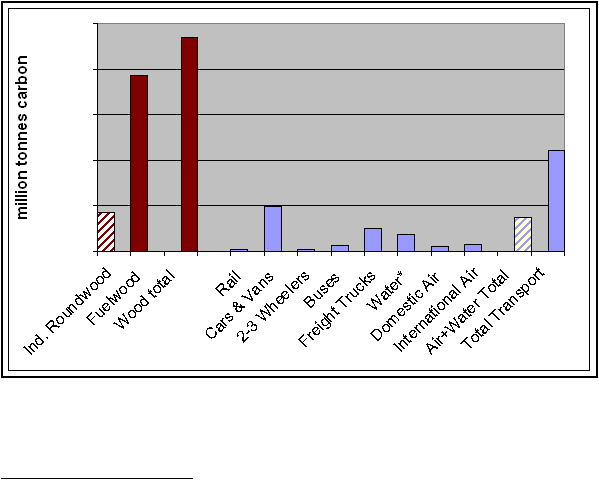
7.4
Offsetting and Sequestering
Forestry projects may be one method that could be used to absorb CO2 emitted from both air and water based
transport. Unfortunately, current methods of offsetting use a piecemeal rather than a global approach, and the
carbon emissions reduced through well managed schemes in one area may be exceeded by illegal logging
activities in another. It is also unclear what will eventually happen to the wood grown in these forests
throughout its life cycle, since there is a danger that the carbon absorbed will be simply released back to the
atmosphere in the form of CO2 or methane when the wood products decompose. However, if illegal practices
can be contained and the subsequent timber managed, it may be possible to use industrial wood actually
present in the form of trees or wood products, as a offsetting guide to a suitable emissions limit allowed for sea
and air transport. Note this method fundamentally differs from most present offsetting schemes that use the
carbon to be absorbed in future forests which is clearly unacceptable.
Whilst some waste wood might be suitable for offsetting fossil fuels such as co-firing in power stations, all of
this not be suitable due to embedded fixtures and toxic preservatives. Any remaining wood could still be
sequestered in managed landfills since the rate of wood decomposition underground is very low.
69
Interestingly,
the amount of carbon contained in industrial roundwood is approximately equal to that released through air and
water transport combined (see figure 32 and spreadsheet 6) and if parity could be maintained, this could be a
useful offsetting mechanism.
The caveat here however, is that industrial forestry can release greenhouse gas emissions due to the tilling of
land and the use of nitrogen fertilisers. One solution may be to use charcoal-based fertilisers where the carbon is
at least temporarily locked in the ground. This charcoal can be produced from specially constructed fuelwood
stoves for cooking.
70
Since the amount of global fuelwood consumed is substantial (see figure 33 and
spreadsheet 6), this could present a useful contribution to global carbon reductions, and also present a cash
opportunity for poorer communities especially if included in a carbon trading scheme.
0
500
1000
1500
2000
2500
Figure 33 Carbon adsorbed and emitted through forestry and transport
*A more recent UN study placed the CO2 emissions of shipping at a higher figure of 1.12 billion tonnes of CO2, or 300 million tonnes of
carbon
71
69 The Decomposition of Forest Products in Landfills, International Biodeterioration and Biodegradation, Micales J.A.; Skog K.E. 1997,
Volume 39, Number 2, 1997 , pp. 145-158(14) Elsevier
70 Biochar

